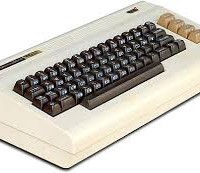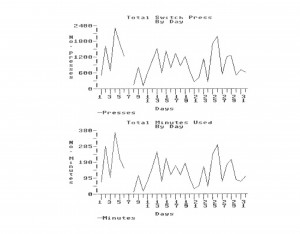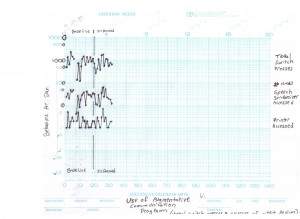Using a Microcomputer to Collect Behavioral Data on an Augumentative Communication Program (1989)

©1989, 2013 by Dallas Denny, Wendy McAmis, & Claude Salyer
Source: Denny, Dallas, McAmis, Wendy, & Salyer, Claude. (1989, October). Paper presented at the Second Annual Conference, Tennessee Association for Behavior Analysis, Kingsport, TN. (Winner, 3rd prize)
Using a Microcomputer to Collect Behavioral Data
on an Augmentative Communication Program
Dallas Denny
Peabody College of Vanderbilt University
and
Greene Valley Developmental Center
and
Wendy McAmis
Claude Salyer
Greene Valley Developmental Center
Presented at and 3rd Place Prize Winner
Second Annual Conference, Tennessee Association for Behavior Analysis
Kingsport, TN, October, 1989
Abstract
Abstract
Microcomputers have come into common use as augmentative communication devices for persons with severe motor impairments which render them unable to speak. With the appropriate software, they allow the user to construct messages which can then be output to speech synthesizers, printers, and telephone lines. Microcomputers have also become popular as devices for collection of behavioral data. Typically, observers must manually enter data from the keyboard. Such manual entry introduces variability into the data. We added automatic data collection routines to a microcomputer-based augmentative device which has been used for more than five years by an adult male nonretarded resident of Greene Valley Developmental Center. Data are presented for frequency and length of use, number of selections made, and messages constructed. In the future, the system will be used to measure the effectiveness of changes in the augmentative communication program.
Microcomputers have come into common use as augmentative communication devices for persons with severe motor impairments which render them unable to speak. With the appropriate software, they allow the user, via one or more adaptive switches, to construct messages which can then be output to speech synthesizers, printers, and telephone lines. Microcomputers have also become popular as devices for collection of behavioral data. Typically, observers must manually enter data from the keyboard. Such manual entry introduces variability into the data. We added automatic data collection routines to a microcomputer-based augmentatative device which has been used for more than five years by an adult male nonretarded resident of Greene Valley Developmental Center. The data were collected by the computer, without the necessity of a human observer. Data are presented for frequency and length of use, number of switch closures, and accesses of output devices. The current data will the used as a baseline against which to compare performance after planned changes in the augmentative communication program.
Method
Subject
W. is a 55-year-old resident of Greene Valley Developmental Center. He is nonretarded, but is physically unable to speak. His motor disability makes it impossible to use a keyboard, even with the help of a mouth-held pointer. W. can, however, operate a single electromechanical switch with his foot.
Apparatus
For the past 5 years, W. has used a Commodore 64 microcomputer as an augmentative communication aid. A BASIC program written by the first author monitors a foot pedal and allows W. to build English sentences, which he can then output to a Votrax speech synthesizer or dot matrix printer.
We added a short subroutine to W.’s communication program; this resulted in the saving of performance data to disk. Disks were removed every two or three days and data were analyzed. Data collected included number of presses of the adaptive foot switch, the approximate length of time the program was in use, the number of times the Votrax speech synthesizer and printer were accessed, the number of selections made, the number of words constructed, backspaces (partial erasures), and the actual messages constructed. Hard copy of these data were generated, and the data were examined and graphed.
Results
Data were collected for 32 days (9/22/89-10/23/89).
Program Use
The program was used daily, with the exception of day 7. Typically, W. would turn the computer on in the morning and leave it on until bedtime. The time during which W. actually operated the program ranged from 10 minutes to 370 minutes daily. Total time of use for the 32-day period was 4140 minutes (69 hours). Mean time in use daily was 129 minutes.
Switch Closures
The number of switch closures ranged from 121 to 2320 daily. There were 30,051 total switch closures, for a mean of 939 closures daily. As it takes six presses of the switch to select a letter or output to the printer of speech synthesizer, a mean of 156 selections were made daily.
Accessing Output Devices
The printer was accessed a total of 66 times (daily mean was 2.96 accesses). The Votrax speech synthesizer was accessed a total of 847 times (daily mean was 26.4 accesses).
Discussion
To the authors, the most striking thing revealed by the data was the astonishing amount of work and time it takes for W. to construct a single message. On most days, his considerable efforts resulted in but a short sentence or two.
The large number of accesses of the Votrax speech synthesizer relative to accesses of the printer suggested W. was using the speech synthesizer as a feedback device. Examination of his messages revealed this was the case. In many instances he would erase a word and try an alternative phonetic spelling. Only when the message met his approval would he generate a hard copy.
Our current efforts are primitive, but have already revealed several important facts of the usage of W.’s augmentative communication program. However, the most important use of this data will be as a baseline to judge the merit of anticipated future changes in the program.


